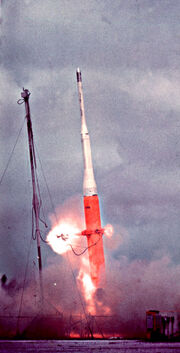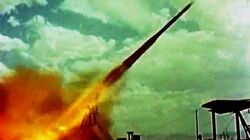
A Lockheed X-17 experimental rocket and it's ground crew.
Data[]
| Statistic. | Data. |
|---|---|
| Type. | Atmospheric re-entry testing unit. |
| Height. | 40 ft 4 in (12.3 m). |
| Diameter. | 1st stage: 2 ft 7 in (0.79 m), 2nd stage: 1 ft 5 in (0.43 m) and 3rd stage: 0 ft 9.7 in (0.25 m). |
| Weight. | 3,400 kg (7,400 lb). |
| Payload. | Some weighted test probes, cameras and senors. |
| Speed. | Mach 14.5. |
| Steering. | N\A, but probably akin to aircraft of comparable role, configuration and era. |
| Nationality. | American. |
| Made by. | Lockheed Corporation. |
| Guidance system. | N\A. |
| Maximum altitude gained. | 500 km (310 mi). |
| Range. | 135 miles (217 km). |
| First made. | 1955. |
| Fist used. | 1955. |
| Retied on. | 1958. |
| Thrust. | 220.00 kN (49,450 lbf). |
| Engines | N\A, but probably akin to those of comparable role, configuration and era. |
| Sources | http://www.designation-systems.net/dusrm/app1/x-17.html, http://users.dbscorp.net/jmustain/x-17.htm, http://en.wikipedia.org/wiki/Lockheed_X-17, http://www.astronautix.com/x/x-17.html and http://www.astronautix.com/lvs/x17.htm |
- Wingspan- 7 ft 7 in (2.3 m).

The X-17 made its maiden flight in 1955. An X-17 re-entry vehicle test launch. The bright flames in the rocket’s center are from small "spin rockets" that made the X-17 stable by imparting a counter-clockwise rotation at launch.
The idea[]
To create a successor to the Astrobee rocket and Black Brant I rocket.
History[]
The Lockheed X-17 was a three stage solid-fuel research rocket to test the effects of high mach atmospheric re-entry. It took off from Patrick AFB at one point and reached the speed of Mach 14.5.
The X-17 was also used as the booster for the Operation Argus series of three high-altitude nuclear tests that were conducted in the South Atlantic during 1958.
Technical note[]
Whist it was puny in comparison to other later rockets, both it and other related rockets like the unguided suborbital sounding rocket, the Astrobee rocket and the Black Brant I rocket rocket were, non the less, a vital stage in researching early space data such as how high speeds and extreme g-forces would affect aviation machinery.
Also see[]

X-17 Research Rocket "The X-17 Story" 1958 US Air Force, Lockheed Solid Fueled Test Missile
"A 1958 Air Force film that documents an obscure but very important missile that was used to test the effects of hypersonic flight on early reentry vehicles. The film is introduced by Major General Bernard Schriever, who was in charge of all early Air Force missile development. Early flight tests of the X-17 took place at Holloman AFB. A total of fifty-one X-17 were later launched from Pad 3 at Cape Canaveral Air Force Station."
- Saturn V rocket
- Vostok 1 rocket
- Bell Textron Rocket Belt
- Bell Pogo
- KGB Chita Jet Belt
- Bell X-1
- North American X-15
- Patrick Air Force Base
- American X-aircraft